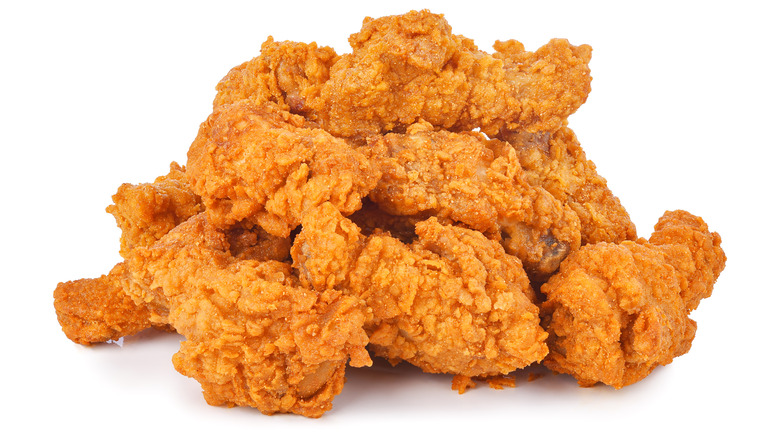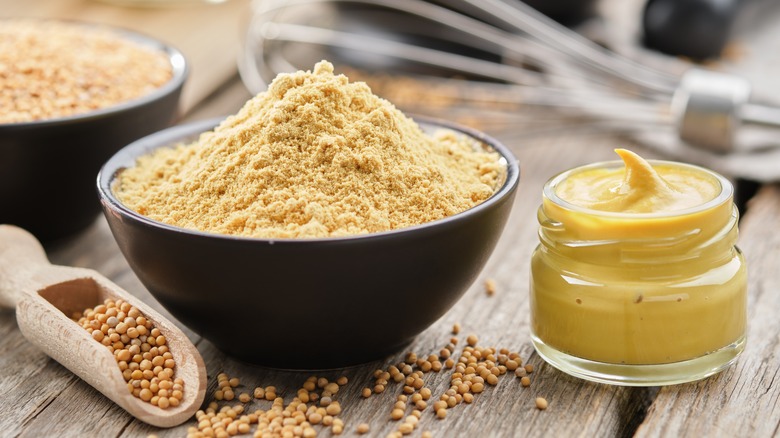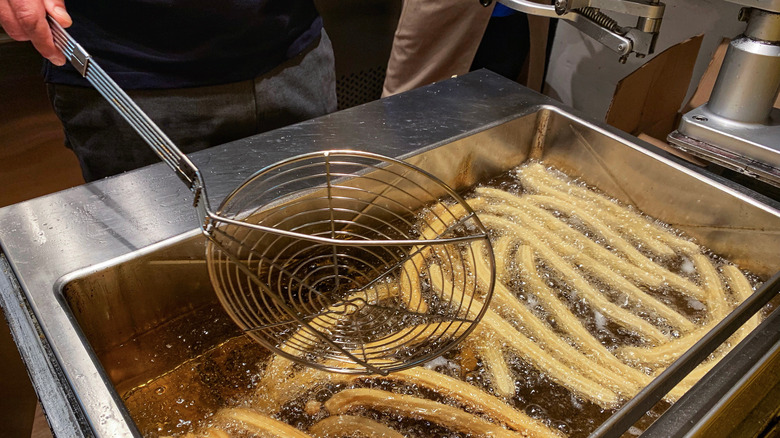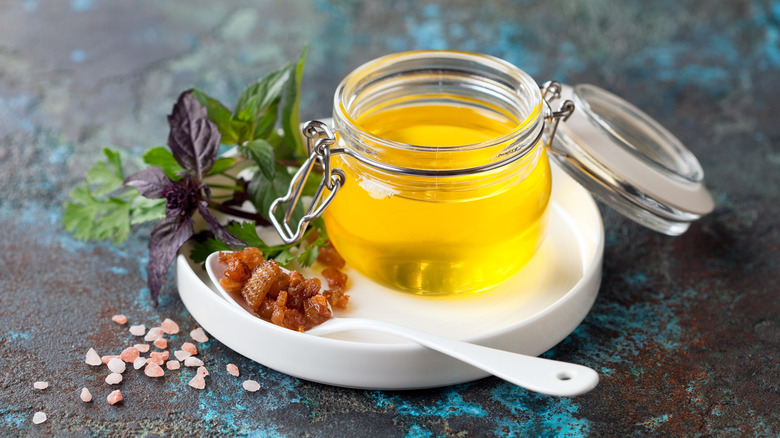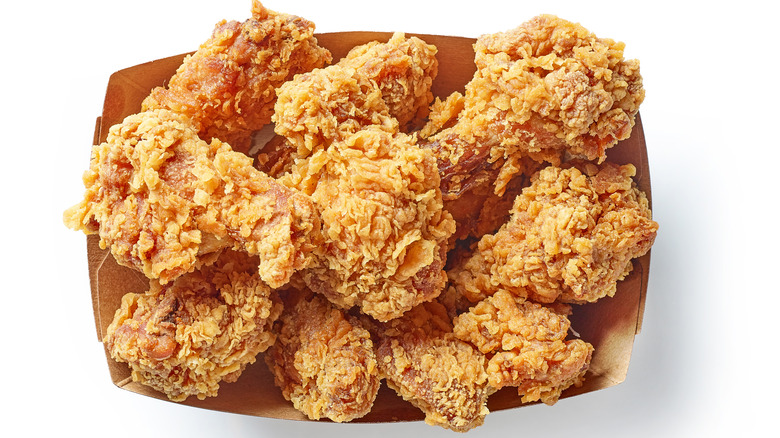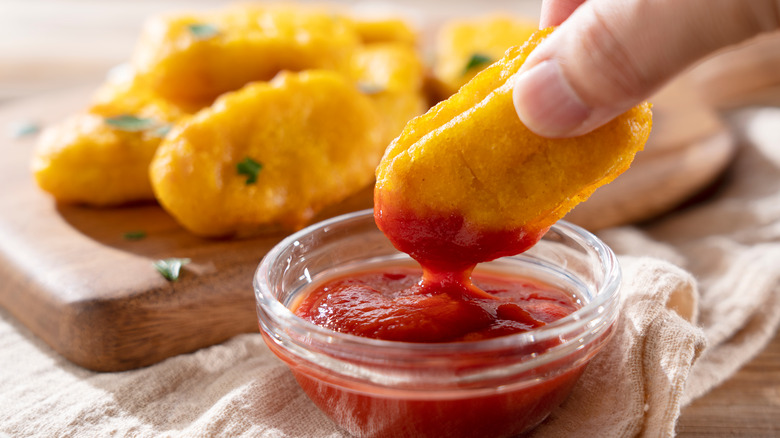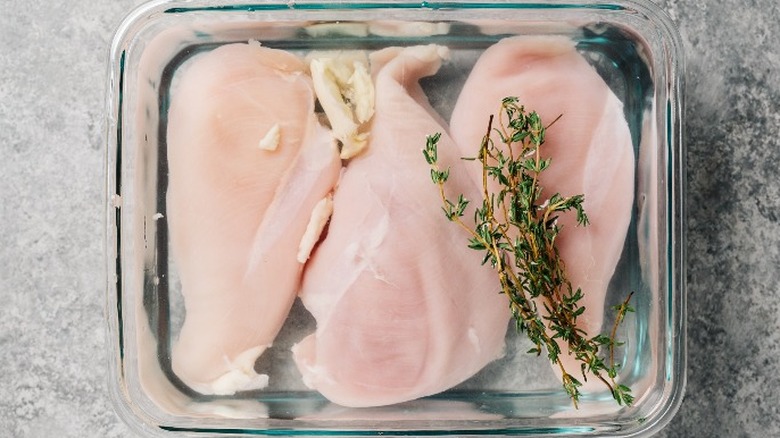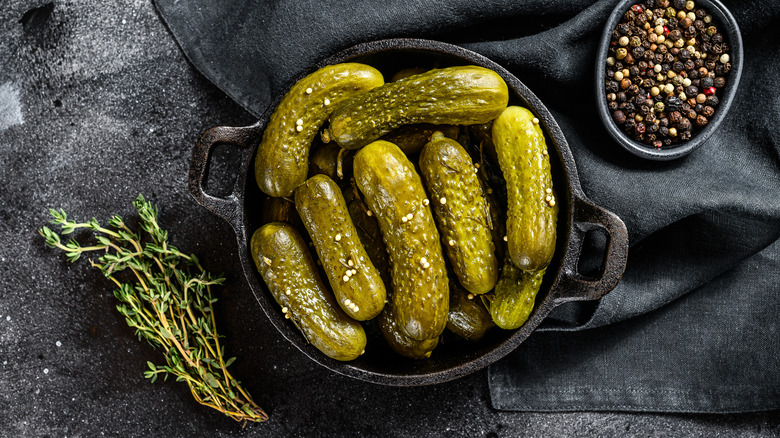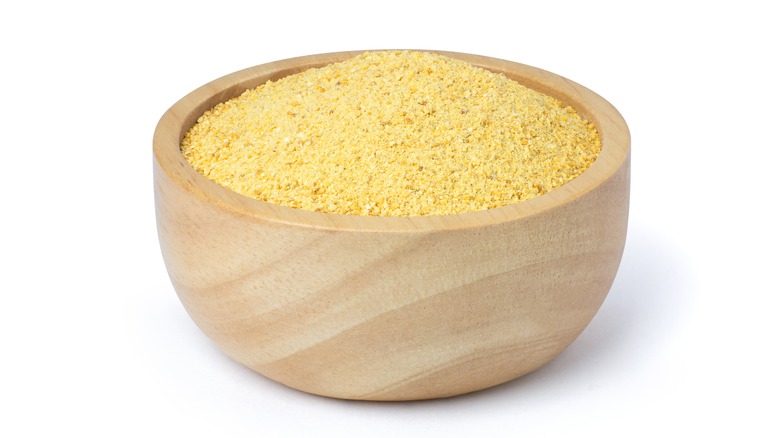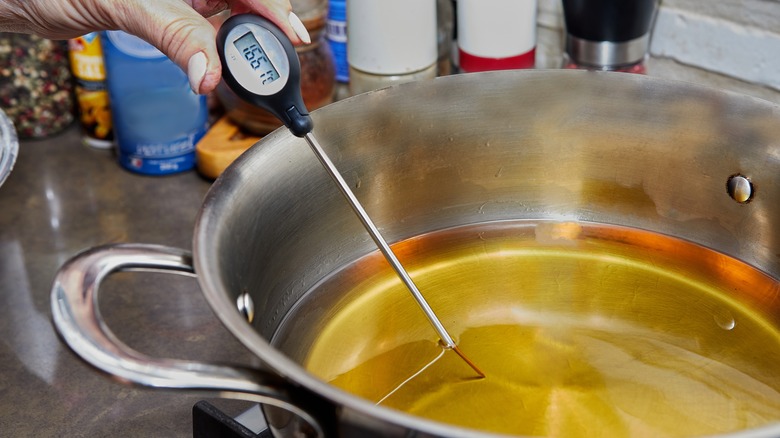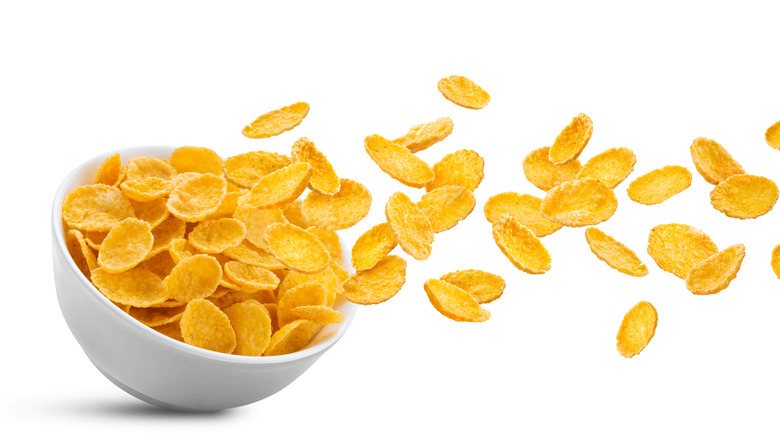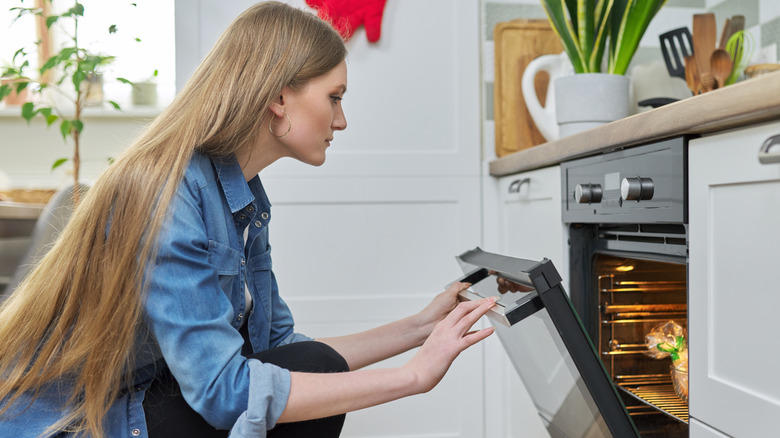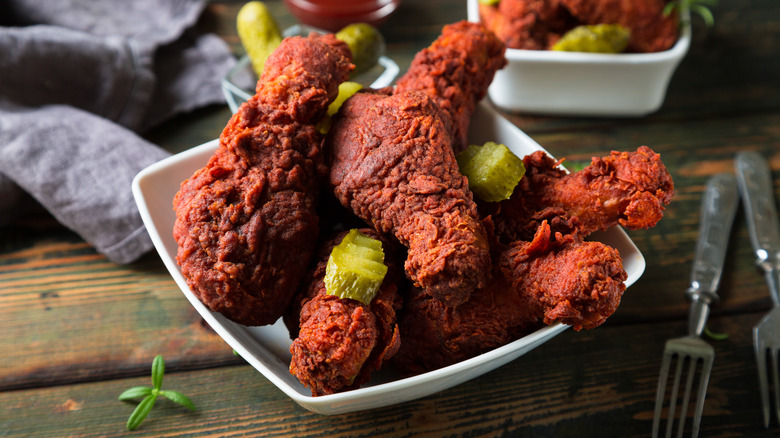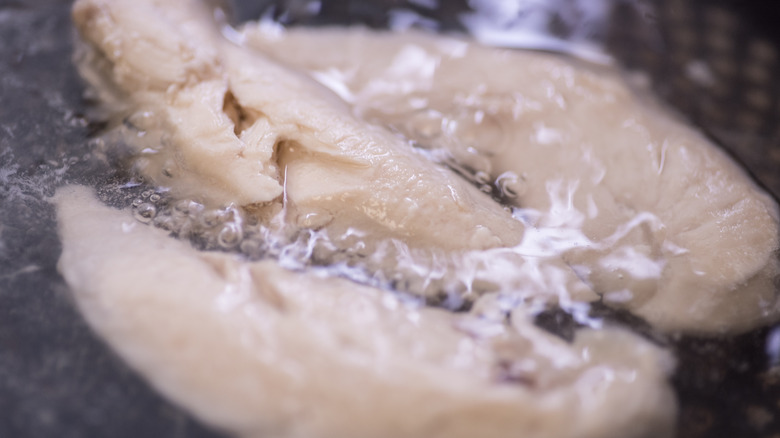13 Secrets To Making The Best Fried Chicken Ever
Some foods are worth making yourself, and some are worth buying at a restaurant — fried chicken is firmly in the latter category. It's time-consuming and messy to make at home. First, you have to brine it, then there's the dredging process, not to mention dealing with the hot oil once you've finished cooking. That's why, if you are going to attempt to make it at home, you want to be sure you are making the very best fried chicken ever.
There are a few tips and tricks to achieving that heavenly nirvana of perfectly juicy chicken with a shatteringly crisp crust. We've rounded up the best knowledge from our test kitchen and chefs around the country to bring you the inside track on insanely good fried chicken. Whether it's a simple twist on the classic technique or a commandment so etched into the fabric of proper chicken cooking, it may as well be in stone; read on for the best secrets of cooking fried chicken.
Add mustard
Mustard on its own has a strong flavor that can stand up to even the heaviest of flavors. In small amounts, however, mustard can be used as a secret ingredient to add a subtle sharpness to all kinds of recipes. You can use mustard powder in a rub or mixed into creamy pasta dishes like macaroni and cheese to enhance the flavor. When making fried chicken, mustard is a simple and easy addition that packs tons of flavor and works perfectly with the peppery, crunchy, delicious breading.
In this recipe for mustard fried chicken, you dry each piece off and baste it with yellow mustard after marinating the chicken in buttermilk. You could also switch out the yellow mustard for a dijon or spicy brown for some more complex flavor. From there, go straight to dredging in flour and frying. Top with a little drizzle of honey for a sweet twist.
Grab a spider
No, we're not talking about the eight-legged insect. A spider is a specialized tool used mainly for frying or poaching different foods. It features a long handle to keep your arms far from hot oil splatters and a wide strainer at the end meant to plunge into liquid or oil to strain out food easily. It's the perfect tool for deep frying chicken because it can easily scoop up multiple pieces of chicken from even the deepest fry pots.
The spider can also be used during breading to quickly remove dredged chicken from flour — mess-free. To start, find a bowl bigger than the width of your spider. Then, place the spider at the bottom of the bowl. After fully dredging the chicken in the flour, simply lift the spider and shake it to remove any excess flour. From there, you can go straight into the frying oil.
Use duck fat
Most restaurants use an oil with a high smoke point for frying, usually something with very little flavor so as not to clash with the flavor of the fried food. For something with a bit more flavor, high-quality duck fat works as a great alternative for frying chicken. Take a page from Takashi Yagihashi's book and fry bite-size pieces of chicken in savory duck fat. At his restaurant Slurping Turtle, Yagihashi repurposes duck fat leftover from duck confit to make delicious fried karaage. This fat is already flavored with the rich taste of duck, along with the bay leaf, peppercorns, and other spices used when curing the duck.
You can find pre-rendered duck fat at butcher shops and specialty grocery stores. If you want to replicate the flavors of Yagihashi's chicken, steep herbs and spices into the fat at a low temperature before straining and continuing with the frying procedure as normal.
Let it come to room temp
One of the biggest mistakes a cook can make when frying chicken is not respecting the scientific relationship between temperature and cooking. If you try to fry chicken straight from the refrigerator, you'll end up with chicken that's overcooked on the outside and raw on the inside. According to Richard Hales, the executive chef of Bird & Bone in Miami, if you let it come to room temp, "the chicken will cook faster, and the juicy inside will be done before the outside gets too dark."
Of course, you don't want to go too far in the other direction and let raw chicken hang out at room temperature for hours and hours (also, you should never fry anything that's frozen solid). The best procedure is to let your marinated or brined chicken come up to room temperature for about thirty minutes before dredging. After the final dredge, the chicken should go straight into the fryer oil.
Dunk it
A fantastic way to improve your fried chicken is to pair it with the perfect side sauce. A great dipping sauce is just as important to the overall experience of eating fried chicken as the chicken itself. Some people love simple honey mustard or a sticky sweet barbecue sauce, while others are die-hard ranch or hot sauce lovers. Entire fast food chains have sauces formulated especially for their fried chicken full of secret ingredients to achieve that perfect pairing.
For a fun new dip, try this cumin-herb dip by chef Thomas Chen. He developed this zippy herb sauce specifically to play well with the crispy fatty richness of fried chicken after trying something similar at a restaurant in Paris. There's sweetness from honey and some light acidity from tangy lime juice. If you have some sauce leftover, it also works as a salad dressing or as a yummy sandwich spread.
Make a killer brine
No matter how flavorfully you season your dredging flour, the secret to making the tastiest fried chicken comes from within. Brining is a great culinary trick that involves making a super-salted liquid (often with other aromatics as well) to soak meat in before cooking. The meat absorbs the salt through osmosis, so it's seasoned from the inside out. This works especially well for fried recipes because the oil tends to remove a lot of the seasoning on the exterior.
A standard brine is made with water as the base, but for fried chicken, you can swap out the water for buttermilk. Since the chicken only absorbs some of the salt (depending on the amount of time you brine), you can go for a super-concentrated amount of salt and spices to get the maximum flavor in the quickest possible amount of time. Before cooking, make sure to rinse the chicken and pat it dry thoroughly before proceeding with the rest of the dredging process.
Or try a pickle juice brine
Classic fried chicken calls for a buttermilk brine, but there's a twist on this that's easier and just as flavorful. Pickle juice or brine is the liquid that dill pickles are cooked and stored in. Standard pickle brine isn't very different from most buttermilk chicken marinades. The base is vinegar and water instead of buttermilk, and both are similarly tart and tangy, with a blend of salt, sugar, garlic, and spices steeped in the liquid.
If you want to save yourself the step of making a buttermilk marinade, or you just want to use up some pickle juice kicking around your refrigerator, this may be the perfect tip for you. You can substitute the buttermilk fully for pickle juice or copy this recipe and do a 50/50 blend. Either way, you'll want to soak the chicken for at least an hour but no more than twelve.
Add cornmeal to your dredge
A classic fried chicken dredge is just regular flour with salt and pepper and maybe a touch of spices for flavor. For a crunchier coating, James Beard award-winning chef Sean Brock uses a little bit of cornmeal in his dredge to add a bit of texture and flavor. According to him, that's how his mom made it. Moms always know the best cooking tips, and who are we to argue with all that hands-on experience?
To replicate this in your next batch of fried chicken, you can start with just a few tablespoons of cornmeal in your flour dredge or go all the way up to a 50/50 blend. You won't want to go much higher than that, or you'll risk ruining the texture. While cornmeal can provide a specific kind of crunch separate from flour alone, it can't absorb oil and moisture the same way and won't ever fry up into that perfectly crispy coating that we all love about fried chicken.
Get the frying temperature right
Achieving the perfect fried chicken is about more than just the ingredients that go into the dipping sauce, brine, or even the dredging flour. Frying chicken is just as much about technique as it is about the ingredients. One of the main ways that people screw up their fried chicken is by not frying it at the right temperature. The ideal chicken frying temperature is between 300 F and 325 F, far lower than most other foods are fried at. At this low temperature, the outside will crisp to a perfect golden brown, and the inside will cook to juicy, succulent perfection.
Some classic recipes call for shallow frying the chicken as opposed to deep frying. Because the oil doesn't surround the chicken in these recipes, making sure the oil isn't too hot is even more important. Either way, investing in a quality thermometer will help you know when you're in the right range.
Use cornflakes
Fried chicken doesn't have to be all about the flour coating. Seriously crispy chicken can also be achieved by using simple cornflakes as a coating. You'll likely still want to start with an initial coating of flour, followed by the egg, and then finally the cornflakes. Make sure you aren't buying sweetened! Because plain cornflakes aren't seasoned themselves, you'll want to double down on the seasoning you put into the initial flour dredge. In this recipe by Laura Sampson, she seasons the chicken with Italian seasoning, garlic, and paprika for an extra boost of spicy flavor.
This option can be great for people that eat a gluten-free diet or those that just want something different. The best part about using cornflakes as a coating is that they are crispy right from the get-go. That makes this the best option for making chicken in the oven or an air fryer.
Bake it
Don't feel like heating up a deep vat of hot oil? We can hardly blame you. Who needs to risk death and dismemberment (not to mention a huge mess) for a few pieces of chicken? Luckily, you can totally make fried chicken in your oven. It may not be quite as crispy as true fried chicken, but that doesn't mean it won't taste awesome and satisfy your craving.
This sheet pan fried chicken recipe utilizes a heavy hand of flavorful spices as well as already-crisp panko breadcrumbs to help recreate the flavor and texture of classic fried chicken without the mess or added fat. You'll still want to marinate the chicken in seasoned buttermilk for the best results. The final secret to success with this method is to coat the exterior of the raw, breaded chicken with a spray of avocado oil. This ensures the coating has at least some fat to help conduct heat and achieve maximum crispiness.
Make it hot
Can you take the heat? Down in Nashville, they serve fried chicken with a spicy kick. Called "hot chicken," this spicy take on the classic came to be after a woman (allegedly) attempted revenge on a cheating husband, only to be foiled when he liked the chicken so much he asked for seconds. Hot chicken gets its name, flavor, and characteristic color from a butter mixture blended with cayenne and paprika that gets brushed onto the fried chicken after cooking. You can adjust exactly how hot you want your chicken by adjusting the amount of cayenne in this butter mixture.
For a truly authentic vibe, serve the hot chicken with thick slices of dill pickle. In some restaurants in Nashville, hot chicken can be served on a bun as a sandwich. It's up to you how you decide to serve it, but we recommend a couple of great sides, like coleslaw and macaroni and cheese.
Poach the chicken
One of the best-kept secrets to getting perfect fried chicken in less time is to poach the chicken beforehand. Seem complicated? It isn't. Assuming you've followed our advice to this point, you've already made a seasoned buttermilk brine for your chicken. Instead of tossing that used buttermilk, put it into a pot, chicken and all, and bring it up to a simmer. Cook the chicken in the buttermilk until it's cooked through, then remove and let cool slightly before breading and frying as normal.
While this does add a step (and an extra pot to your kitchen sink), in the long run, it's worth it to ensure that your chicken is completely cooked through. With this method, once you get to the frying stage, you only have to worry about achieving that golden-brown crust and can rest easy knowing the chicken won't come out raw inside.
